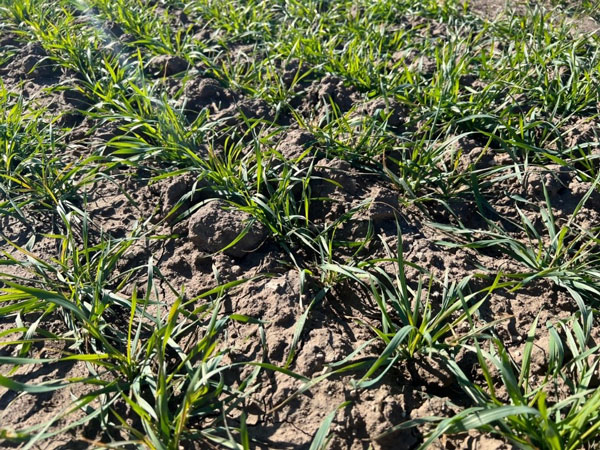Fall forage yield is an important aspect of dual-purpose wheat production. In this system, wheat is typically sown earlier than for grain only production, at higher seeding rates and with additional nitrogen fertilizer to maximize forage production.
The weather experienced during the fall is crucial to determine average level of forage yield, with warm and moist weather typically resulting in greater forage yield than cool and dry weather conditions. Management practices that also maximize forage yield are early sowing, higher seeding rates, placement of in-furrow phosphorus fertilizer with the seed at sowing, and fall nitrogen fertilization.
While the weather is typically the largest player in determining fall forage production, followed by management, there are also differences among wheat varieties in forage production potential. Every year, the K-State Wheat Production Group compares the forage yield of several commonly grown wheat varieties and upcoming lines. This test is usually performed in the South Central Experimental Field near Hutchinson, Kansas (Figure 1), and the forage sampling occurs sometime during December (Table 1).
At the sampling conducted late December 2022, there were significant differences among varieties in terms of forage accumulation. Average forage yield was extremely low (354 lb dry matter (DM)/a) and with a narrow range (from 213 to 679 lb DM/a). The varieties that exhibited the highest forage yield were Guardian and KS Ahearn (Table 1). The remaining varieties produced statistically less forage than these two. The extremely low forage yield was mostly function of limited rainfall availability, as the trial received enough precipitation for proper emergence but almost null precipitation subsequently between emergence and forage measurement (Figure 1).

Figure 1. Dual-purpose wheat trial near Hutchinson, KS. The trial was sown on mid-September 2022, with 50 lbs DAP/acre applied in furrow. Weeds were controlled the week prior to sample collection thus control is still incipient in the photo above. Photo was taken late November 2022.
Table 1. Fall forage yield of wheat varieties sown under dual-purpose system near Hutchinson, KS. Forage biomass was collected on late December 2022. Data is shown in pounds of dry matter per acre (lbs DM/ac). There were significant statistical differences among varieties at the 5% probability level. Varieties are listed in alphabetical order and the bold highlight indicate highest forage yielding group.
|
Variety |
lb DM/a |
|
AM Cartwright |
330 |
|
AP EverRock |
244 |
|
AP Prolific |
459 |
|
AP Roadrunner |
213 |
|
AP18 AX |
304 |
|
ARMOR EXP55 |
314 |
|
ARMOR EXP6_AX |
384 |
|
CP7017 AX |
283 |
|
CP7050 AX |
351 |
|
CP7266 AX |
335 |
|
CP7869 |
403 |
|
CP7909 |
304 |
|
Guardian |
679 |
|
Kivari AX |
375 |
|
KS Ahearn |
489 |
|
KS Hatchett |
314 |
|
KS Providence |
333 |
|
LCS Atomic AX |
436 |
|
LCS Galloway AX |
440 |
|
LCS Steel AX |
286 |
|
LCS19DH-152-6 |
234 |
|
Whistler |
274 |
|
Average |
354 |
|
Minimum |
213 |
|
Maximum |
679 |
Another important aspect of dual-purpose wheat production is how long each variety can be grazed in the spring. This is measured as the date for first hollow stem, and varieties can differ in as much as 20-30 days in achieving first hollow stem in the spring. The Wheat Production Group at K-State uses this very same trial to measure first hollow stem during late February and early March, so stay tuned for more information to come.
Romulo Lollato, Extension Wheat and Forages Specialist
lollato@ksu.edu
Mariana Mota, Visiting Scholar
Luiz Otavio Pradella, MS student